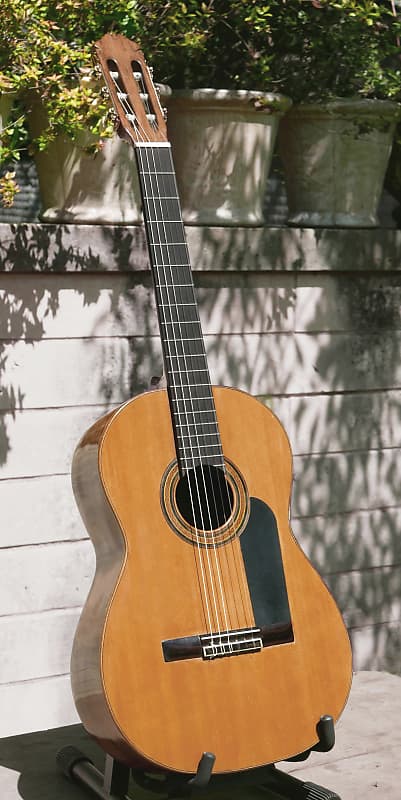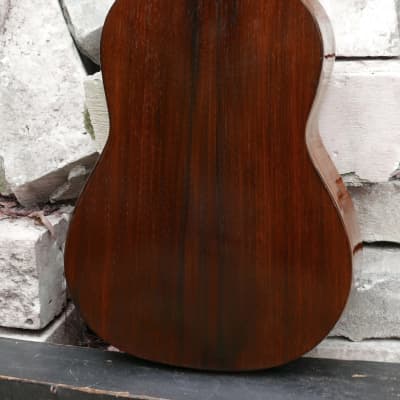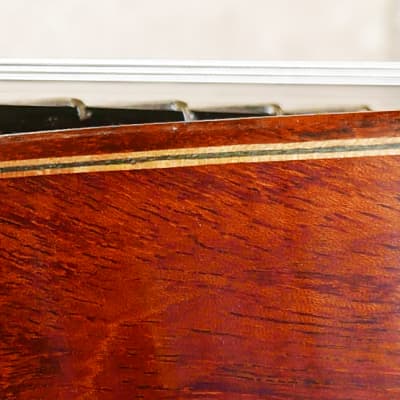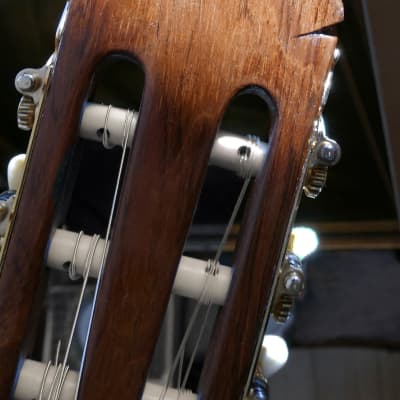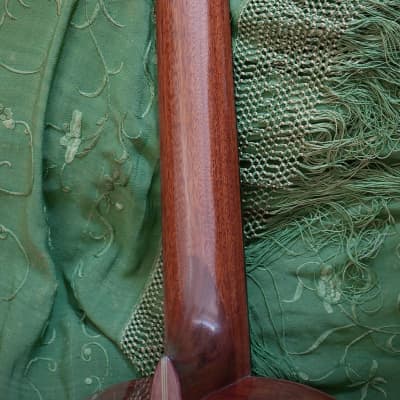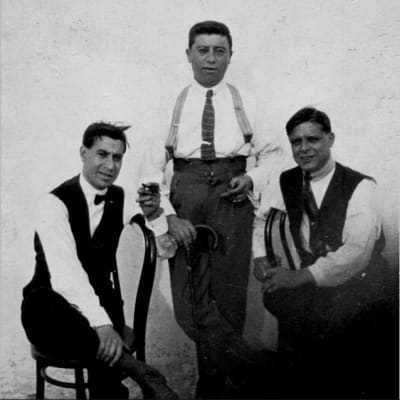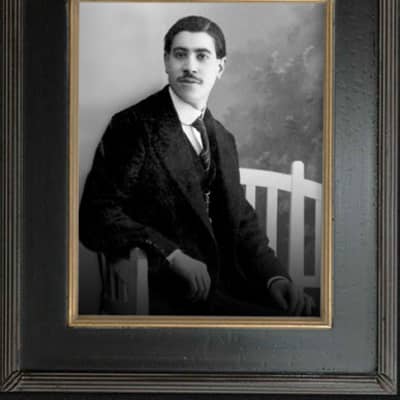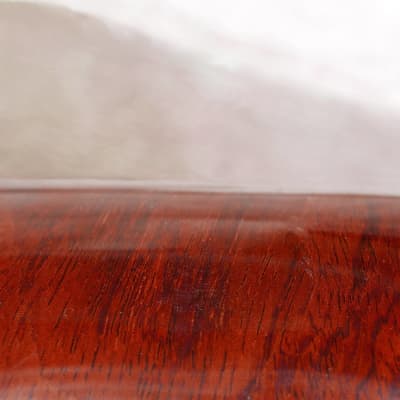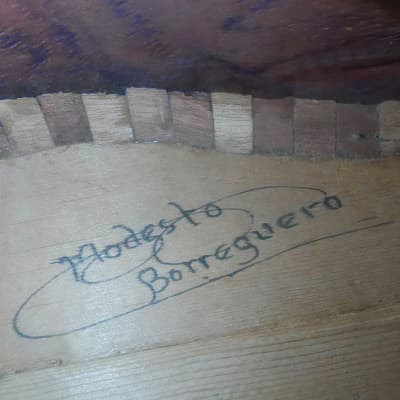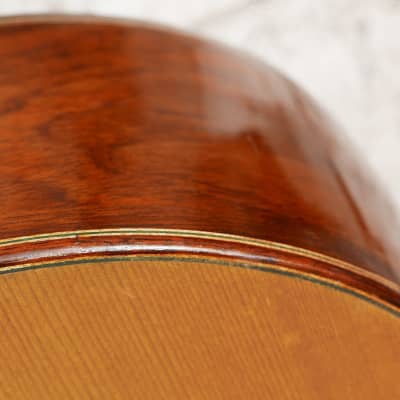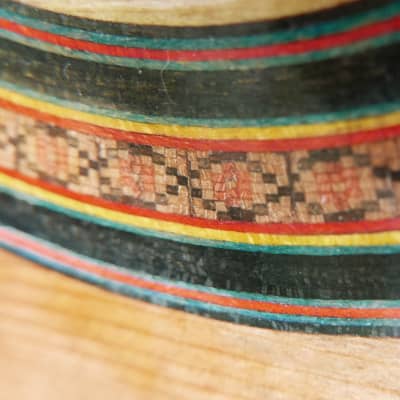Modesto Borreguero (Madrid b. 1893 d. 1969) is among the elite Spanish luthiers of the famous "Madrid school": Borreguero started in the Manuel Ramirez shop, working alongside Santos Hernandez and Domingo Esteso. His guitars are rare on the market today. This guitar is from the even more hard-to-find period of the mid 1940’s to the early 50’s – those were difficult years for all European makers and fewer guitars were produced.
The guitar is signed by Borreguero inside (underside of top), but not dated. We place this guitar from the 40’s to early 50’s – more likely the former, as the great shorter scale length on this guitar would be more in line with the 40’s. The rosette on this guitar is also closer to Borreguero’s 30’s and 40’s style, as is the top and back binding. And the scale length and nut/neck width probably indicates the maker intended the guitar as a Flamenco guitar.
You can hear this guitar, in the sound/video clip under the photo selections.
Here are the specs of this instrument:
• It's signed by the maker, underside of the top
• It feaures a canted fingerboard, ebony. (“Canted” means the thickness of the ebony fretboard, at the sound hole is thicker on the treble side than the bass side – this was done to taper the action).
• Scale length of guitar: 646 mm
• Nut width: 50.5mm
• String spacing at nut: 40mm
• String spacing at bridge: 54mm
• Body depth: 93mm at body/neck joint; 99mm at bottom of guitar
• Brazilian rosewood back and sides (all solid); European spruce top.
Note: the brazilian back is likely a very old replacement of the original. At some point in the instrument’s history, the back was probably replaced with a nice brazilian rosewood set – the work was excellent and it’s essentially impossible to tell inside the guitar. The sides are original, as is the spruce top and original bridge.
• Weight: with strings: 1656 g. This is a light weight for a guitar with Brazilian rosewood back and sides. (Compare to an Esteso, 1929, 657 scale length, with Brazilians back and sides, that is 1500 grams.)
• Fustero tuners
Condition: the guitar has had the following work done, in recent years, by the top restoration experts in the U.S.:
• French polish finish restored
• Fretboard replaced: the original ebony fretboard showed some fret irregularities and divots from refrets over the years, so the fretboard was carefully replaced with an exact match, including a canted design as the original had. (Note, a "canted" fretboard was often used by Jose Ramirez III on his guitars.)
• New black tap plate attached to top
• Fustero tuners (vintage) installed
• In a modern hard shell case.
The tone of this guitar is great – it’s a Flamenco Negra tone with Flamenco-raspy but full bass string response, and clear trebles. Being a “negra” i.e. rosewood back and sides, there’s more sustain than you ever get from the “quick decay” Flamenco blancas, but not too much sustain. The scale length, neck profile, and nut width make it easy and fast to play. A great example from one of the great Spanish luthiers of the Madrid School who now stands along side the greats of Spanish history: Santos Hernandez, Domingo Esteso, and Manuel Ramirez.
Borreguero bio (from the Zavaletas web site):
“Modesto Borreguero was born in 1893, and at age 12 entered the Manuel Ramirez shop on Calle Arlaban as an apprentice, working alongside of Santos Hernandez and Domingo Esteso, among others. Following the death of Manuel Ramirez in 1916, Borreguero was planning to open his own shop, and even had labels printed, but when his Manuel’s widow asked him to continue on, he did, along with Hernandez and Esteso. After a few years, Hernandez and Esteso left to open their own workshops, however, Borreguero continued working for Manuel’s widow until the shop closed around 1923. Even after, his labels touted the fact the had worked for Manuel Ramirez, Antiguo oficial de M. Ramirez. In 1924, Modesto married, and opened a workshop on Duque de Fernan Nuñez, No. 5. However, these were hard times, and during the civil war he lost his shop, and his wife died, leaving him with two children. Struggling on, he moved his shop several times. In 1945 he open a new workshop on Zurita 27 where he worked until 1948. In 1948, he rented space in the workshop of Hernandez and Aguado, who were furniture restorers at the time, at Ribera de Curitdores No 9. Inspired by watching Borreguero build guitars, they too began building guitars. In 1952, Borreguero moved his workshop to Desengaño No 4, and began to build exclusively for the music store Casa Garrido. There he also took on the training of Vicente Perez Camacho, who went on to become a noted luthier. He also taught a young Felix Manzanero how to French polish, a skill that allowed Manzanero to enter Jose Ramirez III workshop as an apprentice. Felix remember’s him as being “somewhat of a bohemian” and being “a generous man, who enjoyed drinking, and so was often broke.” His son Enrique Borreguero (b. 1925) also went to work for Ramirez. Modesto Borreguero retired in 1963, and died in 1969.
